|
Zoysiagrass at St. Martins...
Dan Meersman, Philadelphia Cricket Club, Philadelphia, PA:
 "Yesterday we completed Phase 1 of our St. Martins work by sodding all of our tee-tops to zoysiagrass.
We also installed a small area on #1 fairway, as we believe zoysiagrass is a likely option for a future fairway turf at St. Martins. The prime users of St. Martins will really enjoy the zoysiagrass lie, as the ball sits straight up in the air as if it was on a tee. As a warm-season turf, zoysia looks its best during the middle of the summer, exactly when St. Martins is most heavily used.
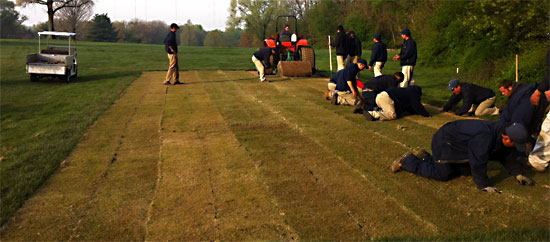
"Agronomicallly, zoysiagrass makes sense for many reasons. It is extremely heat tolerant, and requires less water, chemical, and fertility requirements..." |
Agronomicallly, zoysiagrass makes sense for many reasons. It is extremely heat tolerant, and requires less water, chemical, and fertility requirements. Zoysiagrass will go dormant, which means growth will be very slow in the spring in and in the fall. This is good news as it means that that we will not be spending unnecessary dollars mowing the turf when the golf course is not being heavily used.
From a conditioning standpoint, members will be happy to know that St. Martins can easily become a world-class golf experience, and still remain as a relatively simple and cost-effective golf course to maintain.
We will heavily topdress the tees as soon as they root. This will make them firm and perfectly smooth. Come summer, a time when other grasses begin to struggle with the heat, our tees will be healthy and bright green.

The small trial area on #1 fairway also serves as a driving range tee for our Jr. Camps at St. Martins. This turf will be much more enjoyable for the juniors to learn the game as it will be easier for their shots to get airborn."
Visit Dan's blog at philacricketgm.blogspot.com.
|
 |
|
Bulk Fertilizer Application...
Josh Clevenger, Claremont Country Club, Oakland, CA:
  "Beginning today we will be applying our bulk organic fertilizer to all of the short cut turf areas around the golf course. This will include tees, approaches and fairways. I am a big fan of using organic products on the golf course and the eight tons of 8-2-2 fertilizer that will be applied is exactly what our sand based fairways are in need of this time of year. Unfortunately with any organic fertilizer comes an aroma. To most, that aroma is not very pleasant.
If you are on the course over the next few days, you will know what holes have been fertilized and which have not. The timing is perfect for us to make the application as most of the fairways have been core aerified and the forecast is for more rain to begin tomorrow. Once the rain starts and begins to break down the fertilizer, the smell will go away and all things will return to normal at this wonderful facility."
Visit Josh's blog at claremontturf.blogspot.com (custom blog theme by TurfNet!)
|
 |
|
Greens Health: Managing Thatch...
Cody Beckley, Nutters Crossing Golf Course, Salisbury, MD:
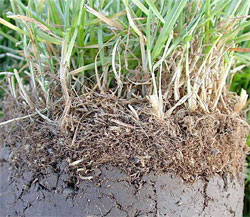
The "hairy" layer between the grass
and the soil is thatch.
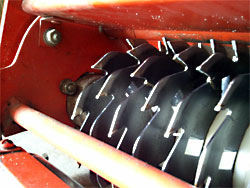
These are our brand new blades which are
very aggressive at removing thatch.
|
 "One of the keys to healthy greens is a healthy soil profile. One common enemy to a healthy soil profile and a healthy green is thatch. Thatch is an accumulation of dead and decaying organic material just below the putting surface. It occurs naturally and too much of it can be a very bad thing.
Too much thatch on a putting surface causes the green to feel spongy when walked on and bumpy when played on. Thatch restricts water penetration into the soil, and causes turf to become shallow rooted. A good superintendent manages thatch production by being prudent with watering and fertility treatments and employing cultural practices when needed.
As I've monitored the greens this spring, I've noticed we could do with some thatch removal. One method we will use through the spring and fall is to verticut. Verticutting is the process of using saw style blades and cutting grooves in the turf. The blades remove the thatch layer and leave room for sand to be incorporated if desired.
Despite the disruption to the surface, this process of verticutting and topdressing with sand will help to smooth out the putting surface."

Visit Cody's blog at nutterscrossing.blogspot.com.
|
 |
|
Quilchena Wildlife...
Jason Hooper, Quilchena Golf Club, Quilchena, BC, Canada:
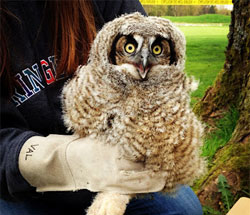  "A Turf Care crew member discovered a juvenile Great Horned Owl on #3 today. It appeared to be injured so O.W.L. (http://www.owlcanada.ca/) was contacted and they arrived shortly after to pick it up and take it back to their centre for rehabilitation. We will be contacting them regularly for progress updates and if all goes well we hope it will be released back on the golf course.
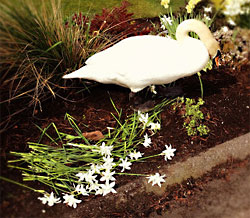 Other wildlife was making noise at Quilchena this week. That’s right, our resident swan was up to her old tricks of ensuring that our new Head Horticulturist, Jacqui, is aware of her gardening preferences. Our swan made it clear that she was not happy about where Jacqui chose to plant some daffodils around the putting green. As you can see, we witnessed her plucking the daffodils and piling them off to the side one at a time right after they were planted. Jacqui now knows to check with the swan before any final plant material decisions are made." Other wildlife was making noise at Quilchena this week. That’s right, our resident swan was up to her old tricks of ensuring that our new Head Horticulturist, Jacqui, is aware of her gardening preferences. Our swan made it clear that she was not happy about where Jacqui chose to plant some daffodils around the putting green. As you can see, we witnessed her plucking the daffodils and piling them off to the side one at a time right after they were planted. Jacqui now knows to check with the swan before any final plant material decisions are made."
Visit Jason's blog at qgolfclub.blogspot.com (another custom blog theme by TurfNet).
|
 |
|
Greens Height in Dollars & Sense...
Brian Boyer, Cinnabar Hills Golf Club, San Jose, CA:
  "Today we took the mowing height of the greens down to 0.100" from 0.110". Even I have trouble wrapping my head around how low technology allows us to cut so I figured I put it into terms all tax brackets can understand.
If you take five, 100 dollar bills and fold them twice, you will have .100" on the calipers. If you are in the lower tax bracket, you can stack two dimes on top of each other and get .100" on the calipers.
Pretty amazing, if you ask me. We will remain at this height until sometime in mid September. If you check the mechanic's notes, every September I get the itch to go lower for no other reason than we can. The gain in speed is nominal, but I feel our A-4 bentgrass greens are maintained better at these lower heights."
Visit Brian's blog at cinnabarhills.blogspot.com
|
 |
|
Bluebirds!
Rick Tegtmeier, CGCS, Des Moines Golf & CC, West Des Moines, IA:
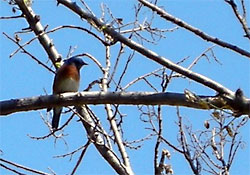  "We have been putting out and monitoring bluebird houses for many years and we have not been very successful. This year I am very happy to say that we finally have a nesting pair of bluebirds at DMGCC.
On #18 North, along the no mow area, there is a bluebird nest box that we put out this spring. It has a #4 on the nest box. The female has laid some eggs and hopefully they will hatch some little ones this spring. They are a very colorful and beautiful bird to watch and have on our property. Please observe them but do not disturb them."
Visit Rick's blog at dmgcc.blogspot.com.
|
Look who's stylin' now! John Slade, of Laurel Creek Country Club in Mount Laurel, NJ, has a new blog theme with custom header courtesy of TurfNet. We would be happy to do that for other TurfNet member/bloggers as well. All we need are a few good course photos (at least 1000px wide), a club logo and a few head shots to work with.

|
 |
|
About our Blog Aggregator: Many superintendents are now hosting private blogs to better communicate with their golfers and/or members. Beyond local weather and course conditions, there is a great deal of information about projects, methodologies and techniques that would be of value to other superintendents — hence our Turf Blog Aggregator. As every blogger struggles occasionally with content, we also include posts intended to educate golfers about turf maintenance for others to use as a template for their own blogs.
Miss any previous issues of TBA? You can find them all here.
Turf Blog Aggregator(TM) is a trademark of Turnstile Media Group.
|
|